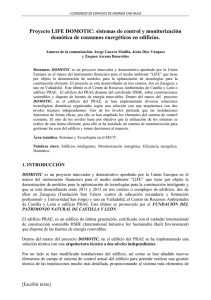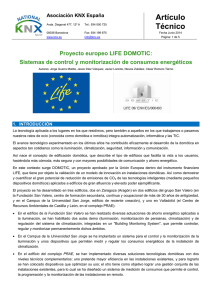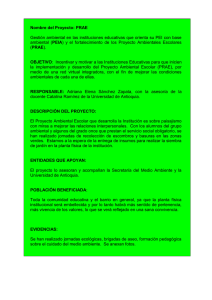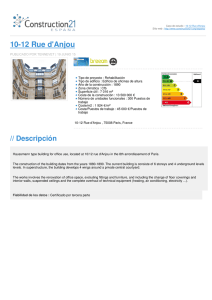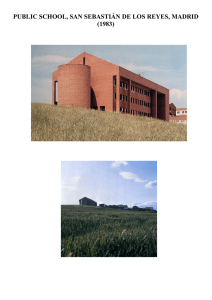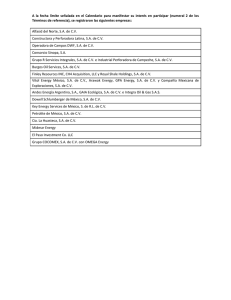proyecto europeo life domotic: modelos de control y
Anuncio
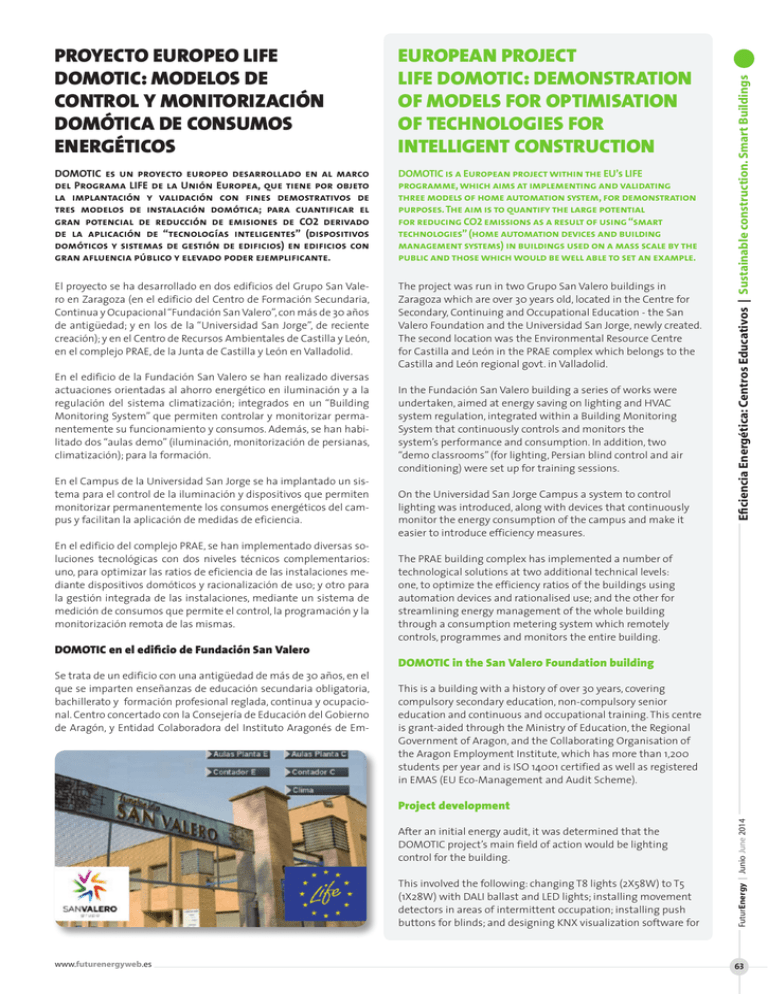
EUROPEAN PROJECT LIFE DOMOTIC: DEMONSTRATION OF MODELS FOR OPTIMISATION OF TECHNOLOGIES FOR INTELLIGENT CONSTRUCTION DOMOTIC es un proyecto europeo desarrollado en al marco del Programa LIFE de la Unión Europea, que tiene por objeto la implantación y validación con fines demostrativos de tres modelos de instalación domótica; para cuantificar el gran potencial de reducción de emisiones de CO2 derivado de la aplicación de “tecnologías inteligentes” (dispositivos domóticos y sistemas de gestión de edificios) en edificios con gran afluencia público y elevado poder ejemplificante. DOMOTIC is a European project within the EU’s LIFE programme, which aims at implementing and validating three models of home automation system, for demonstration purposes. The aim is to quantify the large potential for reducing CO2 emissions as a result of using “smart technologies” (home automation devices and building management systems) in buildings used on a mass scale by the public and those which would be well able to set an example. El proyecto se ha desarrollado en dos edificios del Grupo San Valero en Zaragoza (en el edificio del Centro de Formación Secundaria, Continua y Ocupacional “Fundación San Valero”, con más de 30 años de antigüedad; y en los de la “Universidad San Jorge”, de reciente creación); y en el Centro de Recursos Ambientales de Castilla y León, en el complejo PRAE, de la Junta de Castilla y León en Valladolid. The project was run in two Grupo San Valero buildings in Zaragoza which are over 30 years old, located in the Centre for Secondary, Continuing and Occupational Education - the San Valero Foundation and the Universidad San Jorge, newly created. The second location was the Environmental Resource Centre for Castilla and León in the PRAE complex which belongs to the Castilla and León regional govt. in Valladolid. En el edificio de la Fundación San Valero se han realizado diversas actuaciones orientadas al ahorro energético en iluminación y a la regulación del sistema climatización; integrados en un “Building Monitoring System” que permiten controlar y monitorizar permanentemente su funcionamiento y consumos. Además, se han habilitado dos “aulas demo” (iluminación, monitorización de persianas, climatización); para la formación. En el Campus de la Universidad San Jorge se ha implantado un sistema para el control de la iluminación y dispositivos que permiten monitorizar permanentemente los consumos energéticos del campus y facilitan la aplicación de medidas de eficiencia. En el edificio del complejo PRAE, se han implementado diversas soluciones tecnológicas con dos niveles técnicos complementarios: uno, para optimizar las ratios de eficiencia de las instalaciones mediante dispositivos domóticos y racionalización de uso; y otro para la gestión integrada de las instalaciones, mediante un sistema de medición de consumos que permite el control, la programación y la monitorización remota de las mismas. DOMOTIC en el edificio de Fundación San Valero Se trata de un edificio con una antigüedad de más de 30 años, en el que se imparten enseñanzas de educación secundaria obligatoria, bachillerato y formación profesional reglada, continua y ocupacional. Centro concertado con la Consejería de Educación del Gobierno de Aragón, y Entidad Colaboradora del Instituto Aragonés de Em- In the Fundación San Valero building a series of works were undertaken, aimed at energy saving on lighting and HVAC system regulation, integrated within a Building Monitoring System that continuously controls and monitors the system’s performance and consumption. In addition, two “demo classrooms” (for lighting, Persian blind control and air conditioning) were set up for training sessions. On the Universidad San Jorge Campus a system to control lighting was introduced, along with devices that continuously monitor the energy consumption of the campus and make it easier to introduce efficiency measures. Eficiencia Energética: Centros Educativos | Sustainable construction. Smart Buildings PROYECTO EUROPEO LIFE DOMOTIC: MODELOS DE CONTROL Y MONITORIZACIÓN DOMÓTICA DE CONSUMOS ENERGÉTICOS The PRAE building complex has implemented a number of technological solutions at two additional technical levels: one, to optimize the efficiency ratios of the buildings using automation devices and rationalised use; and the other for streamlining energy management of the whole building through a consumption metering system which remotely controls, programmes and monitors the entire building. DOMOTIC in the San Valero Foundation building This is a building with a history of over 30 years, covering compulsory secondary education, non-compulsory senior education and continuous and occupational training. This centre is grant-aided through the Ministry of Education, the Regional Government of Aragon, and the Collaborating Organisation of the Aragon Employment Institute, which has more than 1,200 students per year and is ISO 14001 certified as well as registered in EMAS (EU Eco-Management and Audit Scheme). After an initial energy audit, it was determined that the DOMOTIC project’s main field of action would be lighting control for the building. This involved the following: changing T8 lights (2X58W) to T5 (1X28W) with DALI ballast and LED lights; installing movement detectors in areas of intermittent occupation; installing push buttons for blinds; and designing KNX visualization software for www.futurenergyweb.es FuturEnergy | Junio June 2014 Project development 63 Eficiencia Energética: Centros Educativos | Sustainable construction. Smart Buildings pleo, que cuenta con más de 1.200 alumnos por curso; certificado en ISO 14001 y Registrado en EMAS a nivel de la UE. Desarrollo del proyecto Previa auditoría energética inicial, se determinó que el ámbito de actuación principal del Proyecto DOMOTIC sería el control de iluminación del edificio. Para ello se realizaron las siguientes acciones: sustitución de luminarias T8 (2X58W), por luminarias T5 (1X28W) con balastro DALI y luminarias LED; instalación de detectores de presencia en áreas de ocupación intermitente; instalación de pulsadores para persianas; y diseño de un software de visualización KNX para la monitorización, activación y desactivación de las escenas programadas, mediante explorador web. Con las acciones realizadas se ha dado cumplimiento a la normativa de eficiencia energética en materia de iluminación, (norma UNE 12464-1) y se controlan los principales valores de eficiencia energética en iluminación (VEEI): iluminancia mantenida (Em), uniformidad, índice de deslumbramiento unificado (UGR) y el índice de reproducción cromática (Ra). Todos los dispositivos instalados están controlados mediante un bus KNX, que permite que el conjunto de la instalación responda a un modelo estandarizado de interoperabilidad. Resultados obtenidos La auditoria inicial indicó que los consumos reales en las áreas de actuación del proyecto DOMOTIC eran de 40.455 kWh/año, lo que representaba el 10,10% del consumo del edificio. En la auditoria de abril de 2014 se confirmó un ahorro en el consumo eléctrico anual del 47,5%. ituación inicial | Initial position S Situación final | Final position Reducción | Reduction Consumo eléctrico (kWh/año) Electricity consumption (kWh/yr) Emisiones (t CO2/año) Emissions (t CO2/yr) 40.455 | 40,455 26,30 | 26.30 21.245 | 21,245 13,80 | 13.80 47,50% | 47.50% www.futurenergyweb.es The work done met the guidelines for energy efficiency in lighting (UNE 12464-1) and the core values of energy efficient lighting (VEEI) are under control: maintained luminance (Em), uniformity, unified glare ratio (UGR) and the colour rendering index (Ra). All installed devices are controlled by a KNX bus, which enables the entire installation to respond to a standardized model of interoperability. Results The initial audit indicated that actual consumption in the DOMOTIC project areas was 40,455 kWh/year, representing 10.10% of the consumption of the whole building. The April 2014 audit confirmed savings in annual electricity consumption of 47.5%. DOMOTIC on the campus of Universidad San Jorge Over 2,000 students study on the Campus of the Universidad San Jorge each academic year and the buildings that have been running the DOMOTIC project (Rector’s office, Faculty of Communication and Faculty of Health Sciences) are less than 10 years old. DOMOTIC en el campus de Universidad San Jorge Project development En el Campus de la Universidad San Jorge estudian cada curso más de 2.000 alumnos y los edificios en los que se ha implantando el proyecto DOMOTIC (Rectorado, Facultad de Comunicación y Facultad de Ciencias de la Salud) tienen menos de 10 años de antigüedad. The three university buildings have been designed and built according to energy efficiency criteria. However, they lacked analyzers and controllers to automate lighting management and energy consumption. Desarrollo del proyecto The three actions taken at the same time on the campus buildings were as follows: installation of detectors to automate lighting in the bathrooms; installation of a KNX control system, as installed in the “Fundación San Valero,” to control lighting in the common areas; and installation and Los tres edificios universitarios han sido diseñados y construidos siguiendo criterios de eficiencia energética. No obstante, carecían de analizadores y controladores que permitieran una automatización de la gestión de la iluminación y de los consumos energéticos. 64 monitoring, enabling and disabling scheduled scenes using a web browser. Las tres acciones aplicadas a la vez para los tres edificios del Campus, han sido: instalación de detectores para automatizar la iluminación de los baños; instalación de un sistema de control KNX, igual al instalado en “Fundación San Valero”, para el control de la iluminación de las zonas comunes; e instalación de Analiza- FuturEnergy | Junio June 2014 Network Analyzers to monitor and control consumption. Connection of home automation systems installed in the three buildings uses KNX/IP routers, which are able to run on existing data networks. Además, la monitorización de los consumos energéticos de cada edificio se realiza mediante ARES, con conversores RS485 a Ethernet, que convierten la información generada para su almacenamiento en dos nuevos servidores instalados. Moreover, monitoring energy consumption in each building uses ARES with RS485 converters to Ethernet, which convert the information produced for storage in two new servers installed there. Resultados obtenidos Results La auditoria inicial indicó que los consumos reales en las áreas de actuación del proyecto DOMOTIC eran de 77.618 kWh/año, lo que representaba el 5,5% del consumo de los tres edificios del Campus. En la auditoria de abril de 2014 se confirmó un ahorro en el consumo eléctrico anual del 65%. The initial audit indicated that actual consumption in the DOMOTIC project areas was 77,618 kWh/year, representing 5.5% of the consumption of the three campus buildings. In the April 2014 audit, savings in annual electricity consumption amounted to 65%. DOMOTIC en el edificio del Complejo PRAE DOMOTIC in the PRAE building complex El Centro de Recursos Ambientales de Castilla y León, situado en el complejo PRAE, es un edificio de última generación, certificado con el estándar internacional de construcción sostenible IISBE (International Initiative for Sustainable Built Environment) que dispone de fuentes de energía renovable. Tiene una antigüedad menor de 10 años y recibe una media de 25.000 visitantes/año. The Environmental Resource Centre of Castilla y Leon, located in the PRAE complex, is a state-of-the-art building with renewable energy sources, and which is certified by the international standard for sustainable construction, IISBE (International Initiative for Sustainable Built Environment). It is under 10 years old and receives an average of 25,000 visitors/year. ituación inicial | Initial position S Situación final | Final position Reducción | Reduction Consumo eléctrico (kWh/año) Electricity consumption (kWh/yr) Emisiones (t CO2/año) Emissions (t CO2/yr) 77.618 | 77,618 50,40 | 50.40 27.166 | 27,166 17,60 | 17.60 65,10% | 65.10% Desarrollo del proyecto El objetivo del proyecto DOMOTIC en el complejo del PRAE se ha orientado a reducir la demanda de energía del edificio garantizando los niveles de confort térmico, acústico y lumínico del edificio. Esto ha exigido, además, gestionar de forma eficaz los parámetros que informan sobre la calidad del aire. Eficiencia Energética: Centros Educativos | Sustainable construction. Smart Buildings dores de Redes para la monitorización y control de los consumos. La conexión de los sistemas domóticos instalados en cada uno de los tres edificios se realiza mediante el uso de KNX/IP routers, que ha permitido aprovechar las redes de datos existentes. Project development The aim of the DOMOTIC project in the PRAE complex has focussed on reducing the energy demand of the building, while ensuring the levels of thermal, acoustic and lighting comfort in the building. This has also meant the need to manage the parameters which provide information on air quality. In the PRAE building, work has gone on at two levels: the first has improved the management of the buildings and has provided more detailed information on production and consumption by installing more elements of decision and control in the system; the second enables accurate analysis of the behaviour of the building and its consumption patterns, through a monitoring system which works in conjunction with the control system. En el edificio del PRAE se ha actuado a dos niveles: con el primero, se ha conseguido mejorar la gestión de las instalaciones y disponer de información de generación y consumo mucho más detallada, instalando en el sistema más elementos de decisión y control; el segundo, permite un análisis preciso del comportamiento del edificio y sus patrones de consumo, mediante un sistema de monitorización complementario al sistema de control. Para mejorar la gestión de las instalaciones se han colocado 21 analizadores de redes., 12 sondas para el control de las UTA´s (10 www.futurenergyweb.es FuturEnergy | Junio June 2014 Management of the building was improved by placing 21 network analyzers, 12 probes for control of UTAs (10 for air quality and 2 for temperature and humidity); 35 presence detectors (hallways, landings, corridors, toilets and kitchen); 2 power meters (thermal solar and air conditioning) and a pulse counter (biomass pellet boiler room). 65 Eficiencia Energética: Centros Educativos | Sustainable construction. Smart Buildings de calidad del aire y 2 de temperatura y humedad), 35 detectores de presencia (vestíbulos, distribuidores, pasillos, aseos y cocina); 2 contadores de energía (solar térmica y climatización) y un contador de pulsos (sala de calderas de pellets de biomasa). Para implementar este sistema de Monitorización, se ha instalado un bus de comunicaciones industrial, MODBUS, al que se conectan los dispositivos y medidores descritos. Una vez diseñada la parte de campo, fue necesario configurar y parametrizar una aplicación (sistema DEIMOS-DEXCELL) que permitiera clasificar la información y tratarla de forma visual e intuitiva; para optimizar los usos del edificio y facilitar la toma de decisiones en base a esta información. Resultados obtenidos Como resultado de la continua supervisión del centro y del análisis de los datos obtenidos, se ha recomendado ajustar a la baja la potencia contratada con la compañía, para adaptarla a las necesidades reales del edificio. Además, en el siguiente cuadro se ofrecen los datos comparados de consumos y producción, desde el inicio del proyecto DOMOTIC hasta la actualidad, con un ahorro de más del 20%. Conclusiones En tres años de desarrollo del proyecto DOMOTIC, se han validado tres modelos de “buena gobernanza de edificios” basados en aplicaciones domóticas, lo que les convierte en ejemplos de referencia para otros edificios con similares usos (centros educativos, universidades, edificios para exposiciones,…) por sus importantes niveles de rendimiento energético. Además se ha logrado más del 50% de reducción del consumo energético demostrado en las tres acciones piloto, en comparación con su demanda energética inicial. Como consecuencia del desarrollo de las tres acciones piloto, se han reducido en más de 400 toneladas las emisiones de gases con efecto invernadero. Por otro lado gracias al desarrollo de las tres acciones piloto demostrativas, se ha reducido el consumo de gasoil para calefacción en más de 30.000 litros/año; el consumo eléctrico en más de 750.000 kWh/ año y el consumo de gas natural en más de 40.000 m3/año. Se ha demostrado el valor añadido de las aplicaciones y tecnologías domóticas presentes en el mercado; que se configuran como útiles herramientas que permiten alcanzar una importante reducción de emisiones con una buena relación coste/beneficio ambiental y económico. www.futurenergyweb.es Además se ha comprobado que mediante la automatización de los edificios, puede reducirse en hasta un 50% el consumo energético en las áreas de climatización e iluminación; en comparación con otras instalaciones convencionales. 66 To implement this monitoring system a MODBUS industrial communications bus has been installed which the devices and meters described are connected to. After designing the field work part, it was necessary to configure and parameterize an application (DEIMOS - DEXCell system) to classify information and treat it visually and intuitively. This optimizes the use of the building and facilitates decision-making based on this information. Results As a result of continuously monitoring the centre and the analysis of the data obtained, it has been recommended that the power level contracted with the supplier be adjusted downwards in order to adapt to the real needs of the building. In addition, the following table shows comparative data on consumption and production from the beginning of the DOMOTIC project to date, with a saving of over 20%. 2011-1012 2013 1014 (Proyección) (Projected) Electricidad | Electricity Energía Solar Térmica Thermal solar Energy Energía Solar Fotovoltaica Photovoltaic solar energy Biomasa (pellets Biomass (pellets 310 MWh 258 MWh 230 MWh 30 MWh (T) 18 MWh 25 MWh ------- 45 MWh 60 MWh 20 t 140 t 130 t Conclusions In the three years of the DOMOTIC project three models of “good building governance” have been validated. This was done on the basis of home automation applications, making them benchmarks for other buildings with similar uses (schools, universities, exhibition halls), as a result of their high levels of energy efficiency. Furthermore a reduction of over 50% was achieved in energy consumption, compared to their initial energy demand, as demonstrated in the three pilot projects. Following the three pilot projects, emissions of greenhouse gases have been reduced by more than 400 tons. In addition, with the development of the three demo pilot projects, the consumption of heating oil has been reduced by over 30,000 litres/year; electricity consumption by 750,000 kWh/year; and consumption of natural gas by more than 40,000 m3/year. The added value of applications and home automation technologies on the market has been clearly demonstrated: these are highly useful tools for achieving a significant reduction in emissions with a good cost/environmental benefit ratio as well as in economic terms. In addition, it has been found that by automating buildings, energy consumption on HVAC and lighting can be reduced Por último, se ha estimulado un comportamiento eficiente en la utiby up to 50%; compared with conventional installations. lización de la energía entre los trabajadores y usuarios (profesores, Finally, efficient behavior in energy use has been given a boost funcionarios, estudiantes y ciudadanos) de los edificios, mediante among workers and users (faculty, staff, students and citizens) el uso de herramientas que evaof buildings, by using tools to evaluate lúan y muestran los rendimienand demonstrate energy output César Pedro Romero, Nieves Zubalez, Julián Lago, Javier Lorente, tos energéticos y los indicadores and associated emission reduction Jesús Diez, Jorge Guerra, Julián Herrero, Raquel Gómez. de reducción de emisiones asoindicators; and these results can Fundación San Valero ciados; y permiten la difusión be publicized within an educational pedagógica de los resultados. context. FuturEnergy | Junio June 2014
